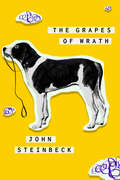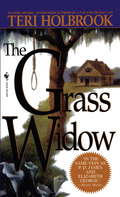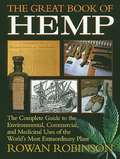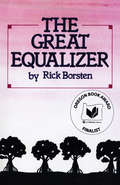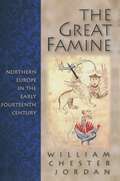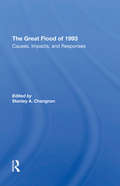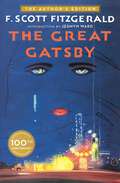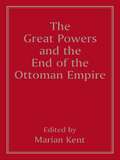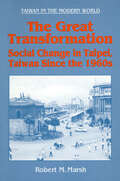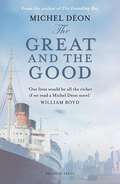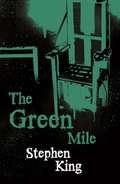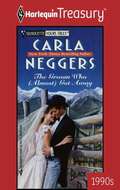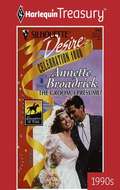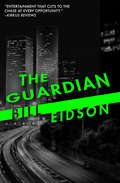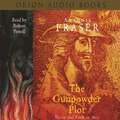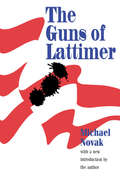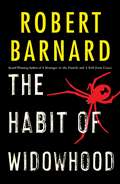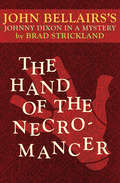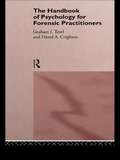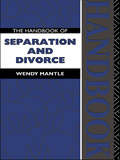- Table View
- List View
The Grapes of Wrath (Globe's Adapted Classics)
by John SteinbeckAn epic human drama depicting the devastating effects of the Great Depression, The Grapes of Wrath won both the National Book Award and the Pulitzer Prize, cementing its place as the most American of American classics. First published in 1939, Steinbeck&’s novel chronicles the Dust Bowl migration of the 1930s and tells the story of one Oklahoma farm family, the Joads, driven from their homestead and forced to travel west to the promised land of California. Out of their repeated collisions with hard realities of an America divided into the Haves and Have-Nots evolves a drama intensely human and yet magnificent in scale and moral. An evocative portrait of the conflict between powerful and powerless, of one man&’s fierce reaction to injustice, and of one woman&’s stoical strength, The Grapes of Wrath probes into the very nature of equality and justice in America. Penguin Random House Canada is proud to bring you classic works of literature in e-book form, with the highest quality production values. Find more today and rediscover books you never knew you loved.
The Grass Widow (Gale Grayson #2)
by Teri HolbrookAfter a tragic exile in England, Gale Grayson returns with her daughter to her southern roots, only to find eccentric relatives--and a decades-old scandal alive and well. They'd been talking about Gale's Aunt Linnie since 1925, when she was found hanging from a pecan tree. When Linnie's grandson is killed by a shotgun blast, it falls to Gale to sort out the truth--and that means she will have to dig deep into the town's darkest secrets--and her own painful past.
The Great Book of Hemp: The Complete Guide to the Environmental, Commercial, and Medicinal Uses of the World's Most Extraordinary Plant
by Rowan RobinsonHemp, Cannabis sativa, has been called the world's most versatile plant. Materials made from hemp fiber have been discovered in tombs dating back to 7000 B.C. During the Middle Ages hemp was used to treat fevers, insomnia, and malaria. Columbus's ships had sails of hemp, and during colonial times it was universally grown because its strong fibers made superior ropes, sails, cloth, and paper. In fact, hemp was used for money in most of the Americas from 1631 until the early 1800s, and the original drafts of the Declaration of Independence and the Constitution were written on hemp paper.As a food, the oil from hemp seeds has the highest percentage of essential fatty acids and the lowest percentage of saturated fats. Britain and Canada have recently lifted bans on growing industrial hemp and today it is reappearing in the marketplace in an amazing array of products: from lip-salve, jeans, salad oil, and cheese to paper products, composite fiberboard, and biomass fuel.This illustrated, easy-to-read guide covers all aspects of hemp:• The history of its cultivation worldwide • Its role as a source of renewable energy and as an alternative for paper manufacturing and fossil fuels• Its versatility as a fiber• Its many nutritional and medicinal uses• Examines the physiological and psychological effects of marijuana use in recreation and therapy• A comprehensive resource section includes information on organizations involved in legalizing hemp, product suppliers, and an annotated bibliography.
The Great Equalizer
by Rick BorsteinRick Borsten’s extraordinary first novel tells the story of Benny Horowitz, a young man who, terrified of the prospects of life after commencement, drops out of college just two weeks before graduation and finds a temporary job working at a halfway house for eight mentally challenged adults whose “deviant” and “inappropriate” behavior he is charged with reshaping. It isn’t long, however, before Benny begins to appreciate the uniqueness of each of the resident’s personalities and the richness of their worlds, and discovers that it is he, not they, who is being reshaped; and reshaped by one resident in particular—Nadia Christov, a mysterious 26 year old artist. It is Nadia’s rare ability to see the world with fresh eyes—to appreciate the natural wonders surrounding her “everywhere and all the time”—that finally convinces Benny it is she who holds the keys to the greatest of his post-commencement fears. While Benny’s story is unfolding, a series of flashbacks traces his unusual family history, beginning with his grandfather, Joseph, who comes to America from Poland in the early 1900s and whose pessimistic vision of death as life’s “great equalizer” is transformed over three generations into one of hope, renewal and wonder. Like Alice Walker’s The Color Purple, The Great Equalizer is a book to cherish, for it nourishes the spirit by reminding us of the transformational power of love.
The Great Famine: Northern Europe in the Early Fourteenth Century
by William Chester JordanThe horrors of the Great Famine (1315-1322), one of the severest catastrophes ever to strike northern Europe, lived on for centuries in the minds of Europeans who recalled tales of widespread hunger, class warfare, epidemic disease, frighteningly high mortality, and unspeakable crimes. Until now, no one has offered a perspective of what daily life was actually like throughout the entire region devastated by this crisis, nor has anyone probed far into its causes. Here, the distinguished historian William Jordan provides the first comprehensive inquiry into the Famine from Ireland to western Poland, from Scandinavia to central France and western Germany. He produces a rich cultural history of medieval community life, drawing his evidence from such sources as meteorological and agricultural records, accounts kept by monasteries providing for the needy, and documentation of military campaigns. Whereas there has been a tendency to describe the food shortages as a result of simply bad weather or else poor economic planning, Jordan sets the stage so that we see the complex interplay of social and environmental factors that caused this particular disaster and allowed it to continue for so long. Jordan begins with a description of medieval northern Europe at its demographic peak around 1300, by which time the region had achieved a sophisticated level of economic integration. He then looks at problems that, when combined with years of inundating rains and brutal winters, gnawed away at economic stability. From animal diseases and harvest failures to volatile prices, class antagonism, and distribution breakdowns brought on by constant war, northern Europeans felt helplessly besieged by acts of an angry God--although a cessation of war and a more equitable distribution of resources might have lessened the severity of the food shortages. Throughout Jordan interweaves vivid historical detail with a sharp analysis of why certain responses to the famine failed. He ultimately shows that while the northern European economy did recover quickly, the Great Famine ushered in a period of social instability that had serious repercussions for generations to come.
The Great Flood Of 1993: Causes, Impacts, And Responses
by Stanley ChangnonThe flood that affected a third of the United States during the summer of 1993 was the nation's worst, ranking as a once-in-300-years event. It severely tested national, state, and local systems for managing natural resources and for handling emergencies, illuminating both the strengths and weaknesses in existing methods of preparing for and dealing with massive prolonged flooding. Through detailed case studies, this volume diagnoses the social and economic impacts of the disaster, assessing how resource managers, flood forecasters, public institutions, the private sector, and millions of volunteers responded to it. The first comprehensive evaluation of the 1993 flood, this book examines the way in which floods are forecast and monitored, the effectiveness of existing recovery processes, and how the nation manages its floodplains. The volume concludes with recommendations for the future, in hope of better preparing the country for the next flood or other comparable disaster.
The Great Gatsby: The Only Authorized Edition
by F. Scott FitzgeraldThe only edition of the beloved classic that is authorized by Fitzgerald&’s family and from his lifelong publisher. This edition is the enduring original text, updated with the author&’s own revisions, a foreword by his granddaughter, and with a new introduction by National Book Award winner Jesmyn Ward. The Great Gatsby, F. Scott Fitzgerald&’s third book, stands as the supreme achievement of his career. First published by Scribner in 1925, this quintessential novel of the Jazz Age has been acclaimed by generations of readers. The story of the mysteriously wealthy Jay Gatsby and his love for the beautiful Daisy Buchanan is an exquisitely crafted tale of America in the 1920s.
The Great Interactive Dream Machine
by Richard PeckJosh Lewis' best friend, Aaron Zimmer, has turned his computer into a wish-granting machine. It ought to be every techno-addict's dream, but there are a few bugs in the system. Nobody knows when the computer will interactivate next--and it doesn't just grant Josh and Aaron's wishes. In fact, Aaron's mom's poodle seems to eb doing some of the wishing, too. When a mysterious spy called The Watcher starts monitoring their every move in cyberspace, the real trouble begins in this compelling story from Newbery medal-winning author Richard Peck. "A guaranteed fun, faced-paced adventure. "--School Library Journal .
The Great Powers and the End of the Ottoman Empire
by Marian KentHow far was the end of the Ottoman Empire the result of Great Power imperialism and how far the result of structural weaknesses within the Empire itself? These studies of the foreign policy of each of the Great Powers and the Ottoman Empire examine these fundamental issues.
The Great Tranformation
by Robert MarshThis study of the effects and directions of social change in Taiwan examines questions such as: what was the society of Taiwan like before the current period of economic growth?; how has it changed?; and are there aspects that did not change, despite the significant transformation in some spheres.
The Great and the Good
by Michel DéonFrom the acclaimed author of The Foundling Boy comes this new classic set in 1950s AmericaArthur Morgan is aboard the Queen Mary bound for the United States, where a scholarship at an Ivy League university awaits him, along with the promise of a glittering future.But the few days spent on the ship will have a defining effect on the young Frenchman, when he encounters the love of his life.
The Green Mile
by Stephen KingStephen King's international bestselling and highly acclaimed novel, also a hugely successful film starring Tom HanksThe Green Mile: those who walk it do not return, because at the end of that walk is the room in which sits Cold Mountain penitentiary's electric chair. In 1932 the newest resident on death row is John Coffey, a giant black man convicted of the brutal murder of two little girls. But nothing is as it seems with John Coffey, and around him unfolds a bizarre and horrifying story. Evil murderer or holy innocent - whichever he is - Coffey has strange powers which may yet offer salvation to others, even if they can do nothing to save him.
The Groom Who (Almost) Got Away
by Carla NeggersThe groom who almost got away? Completely got away is more like it. Max Slade just up and left Calley Hastings without a word. But now, three little Slades suddenly send for her.... What she learns: 1) Max left her to raise his orphaned brothers on their Wyoming ranch. 2) The boys figured Max would smile more if Calley came to marry him. 3) Max still isn't smiling. Now, Calley's in love with four Slade cowboys. And the tall, good-looking one in the Stetson isn't getting away again....
The Groom, I Presume?
by Annette BroadrickThree complete novels from this popular and prolific author are included here: "Megan's Marriage, " which looks at a marriage of convenience; "Instant Mommy, " in which a temporary arrangement might lead to a lifetime of passion; and "The Groom, I Presume?, " about a quick proposal, a stand-in groom, and a hasty wedding.
The Guardian
by Bill EidsonNine-year-old Janine Stearns and her parents stop at a convenience store to buy ice cream. Moments later, a masked gunman walks in and robs the store, shooting the clerk and kidnapping Janine. What begins as a seemingly random act of violence quickly becomes a world of dark interconnections and horrifying possibilities. Nothing is as it appears. It is left to Ross Stearns, Janine&’s uncle and guardian, to rescue Janine and end the nightmare of senseless violence.The Guardian is an experience of shocking power that takes off like a rocket from the very first chapter.
The Guide Dog Mystery (Boxcar Children #53)
by Gertrude Chandler Warner Charles TangThe Boxcar children are helping out at a guide dog training school, there they notice a rare obsession with a particular dog, Ginger, and other mysterious events.
The Gunpowder Plot: Terror And Faith In 1605
by Lady Antonia FraserRemember, remember, the Fifth of November ... With a narrative that grips the reader like a detective story, Antonia Fraser brings the characters and events of the Gunpowder Plot to life. Dramatically recreating the conditions and motives that surrounded the fateful night of 5 November 1605, she unravels the tangled web of religion and politics that spawned the plot.'An excellent book which unravels the whole story of the plot' Literary Review'Told with impressive scholarship and panache ... with a sense of pace and tension worthy of a John le Carré novel' Sunday Telegraph
The Gunpowder Plot: Terror And Faith In 1605
by Lady Antonia FraserWith a narrative that grips the reader like a detective story, Antonia Fraser brings the characters and events of the Gunpowder Plot to life. Dramatically recreating the conditions and motives that surrounded the fateful night of 5 November 1605, she unravels the tangled web of religion and politics that spawned the plot."Told with impressive scholarship and panache... The result is a narrative that is clear, balanced, and builds to its denouement with a sense of pace and tension worthy of a John le Carr novel" John Adamson, Sunday TelegraphRead by Robert Powell(p) 2003 Orion Publishing Group
The Guns of Lattimer
by Michael NovakOn September 10, 1897, in the hamlet of Lattimer mines, Pennsylvania, an armed posse took aim and fired into a crowd of oncoming mine workers, who were marching in their corner of the coal-mining region to call their fellow miners out on strike. The marchers Poles, Slovaks, Hungarians, most of whom could not yet speak English were themselves armed only with an American flag and a timid, budding confidence in their new found rights as free men in their newly adopted country. The mine operators took another view of these rights and of the strange, alien men who claimed them. When the posse was done firing, nineteen of the demonstrators were dead and thirty-nine were seriously wounded. Some six months later a jury of their peers was to exonerate the deputies of any wrong-doing.This long-forgotten incident is here movingly retold by Michael Novak, himself the son of Slovak immigrants and one of our most gifted writers and social observers. In his hands, the so-called "Lattimer Massacre" becomes not only a powerful story in its own right (and an invaluable key to the history of the growth of the united mine Workers), but an allegory of that peculiarly American experience undergone over and over again throughout the land, and down to this very day; the experience of new immigrants, still miserable with poverty and bewilderment and suffering the trauma of culture shock, being confronted by the hostility and blind contempt of the "real" Americans.In Michael Novak's uniquely vivid account, the incident at Lattimer is seen as a tragedy brought on not so much by inhumanity as by the profound failure of majority WASP society to understand the needs and responses of "foreigners." The Guns of Lattimer is a gripping book that tells Americans, old and new, a great deal about themselves and the society they live in.
The Guns of Victory
by George BlackburnFor the Canadian Soldiers who lived through the momentous battle for Normandy in the summer of 1944, it was inconceivable that the conflict in Europe could continue for another eight long months. The war was won, they thought, and to win it they had been pushed to what seemed like the limits of endurance. But ahead lay not only an enemy with no thoughts of surrender, but also appalling battle conditions reminiscent of the legendary miseries of Passchendaele. This much-anticipated sequel to The Guns of Normany picks up where its critically acclaimed predecessor leaves off, and it continues in the same absorbing, startlingly vivid style. After the battle for Normandy, Blackburn's 4th Field Regiment, with the rest of 1st Canadian Army, is called upon to pursue the enemy through the flooded Low Country, clearing the Scheldt estuary - a task equal to that of D-Day - and opening the port of Antwerp to allow for the huge influx of supplies necessary to press on against the German forces, now fighting with mounting desperation and ferocity. After enduring the worst winter in local memory, and spending yet another Christmas far from home, in the spring of 1945 the Canadians are thrust into the crucial Battle of the Rhineland, which will eventually allow Allied forces to plunge into the heart of the Reich.When victory comes, it is with no sense of triumph over a vanquished foe, but with the profoundest relief that this most terrible conflict in history is finally over.Told with Blackburn's now trademark sense of drama and eye for detail, this story of the desperate struggle for Europe becomes as large as life. It should fully establish Blackburn as the author of an acknowledged classic on the Second World War.From the Hardcover edition.
The Habit of Widowhood
by Robert BarnardA young girl is brought up in seclusion by her elderly parents who are obsessed with isolating her from the sinfulness of life in the wicked world. When, to secure her future, they marry her off to an elderly widower, they set in motion events more terrible than the most hateful of parents could have foreseen. A woman with an enticing sexual secret marries an elderly gentleman - and then another and another. It is all too easy, it seems, to get into the habit of widowhood. A young soldier, home from World War I, is determined to live and love not just for himself, but for all his fallen comrades. But in doing so he enrages a number of husbands. A man going through a midlife crisis meets the bully who made his life hell at school. Some things never change, he discovers, including the taste for inflicting pain.
The Hand of the Necromancer (Johnny Dixon #10)
by John Bellairs Brad StricklandIn a Massachusetts town, an evil wizard is about to come back from the dead and a young hero must fight to stop him . . . In the days of the Salem witch trials, the sleepy hamlet of Duston Heights had just one practitioner of the dark arts: the notorious necromancer Esdrias Blackleach. As the fever for witch hunting reached its terrible peak, Blackleach was accused of using powerful black magic against his fellow townsfolk. But just before he could be brought to trial, he dropped dead, escaping justice forever. Or so it seemed . . . Fast forward to the 1950s, the inquisitive young sleuth Johnny Dixon and his mentor Professor Childermass are getting ready to donate a box of Blackleach artifacts to the local museum when a descendant of the sorcerer shows up and attempts to steal his ancestor&’s wooden hand. He has a fiendish plan to raise the old necromancer from the dead, and only Johnny and the professor can stop him and make the town safe from black magic forever. The Johnny Dixon stories, from the award-winning author of The House with a Clock in Its Walls, have been acclaimed for their &“believable and likable characters&” (The New York Times) and &“spine-tingling&” supernatural adventure (Publishers Weekly).
The Hand of the Necromancer (Johnny Dixon #10)
by John Bellairs Brad StricklandIn a Massachusetts town, an evil wizard is about to come back from the dead and a young hero must fight to stop him . . . In the days of the Salem witch trials, the sleepy hamlet of Duston Heights had just one practitioner of the dark arts: the notorious necromancer Esdrias Blackleach. As the fever for witch hunting reached its terrible peak, Blackleach was accused of using powerful black magic against his fellow townsfolk. But just before he could be brought to trial, he dropped dead, escaping justice forever. Or so it seemed . . . Fast forward to the 1950s, the inquisitive young sleuth Johnny Dixon and his mentor Professor Childermass are getting ready to donate a box of Blackleach artifacts to the local museum when a descendant of the sorcerer shows up and attempts to steal his ancestor&’s wooden hand. He has a fiendish plan to raise the old necromancer from the dead, and only Johnny and the professor can stop him and make the town safe from black magic forever. The Johnny Dixon stories, from the award-winning author of The House with a Clock in Its Walls, have been acclaimed for their &“believable and likable characters&” (The New York Times) and &“spine-tingling&” supernatural adventure (Publishers Weekly).
The Handbook of Psychology for Forensic Practitioners
by Graham J. Towl David A. CrightonThe Handbook of Psychology for Forensic Practioners discusses some of the ways in which psychological research and methods can be applied by a wide variety of professional groups working with offenders. The book concentrates on the assessment of risk in forensic settings and the interventions designed to reduce risk in violent and sexual offenders. In three sections it looks at:what we know about offenders; the assessment of risk; and the applicationn of psychological assessment and intervention approaches.By illustrating theoretical practice with case examples and also practical guidance The Handbook of Psychology for Forensic Practitioners develops a very practical focus throughout the text. Each chapter of the book is also designed so that it can be read in isolation and still provide useful guidance. It can be used as an aid to day to day professional practice for those working in forensic settings including probation officers, social workers, nurses, psychologists and psychiatrists.
The Handbook of Separation and Divorce
by Wendy MantleThere are few people whose lives are unaffected by marriage breakdown. Yet how many are well informed about the divorce process and/or appreciate the wide powers the court has to redistribute property and income after divorce? Those who act without the benefit of specialist legal advice can risk impoverishing themselves and their families by accepting less than the court may award them or offering more than the court would order them to give. The Handbook of Separation and Divorce is principally concerned with the financial consequences of marriage breakdown in England and Wales. It suggests what should be done when a marriage is in difficulty and ensures that advice is obtained from a solicitor who is a specialist. It recognises that everyone who separates or divorces will be the poorer and recommends that where appropriate those who can face mediation should undertake it while at the same time ensuring they can get independent legal advice. The Handbook of Separation and Divorce will be essential reading for social workers and health professionals as well as the general reader and those going through, or considering, divorce or separation.
